Estimated reading time: 18 minutes
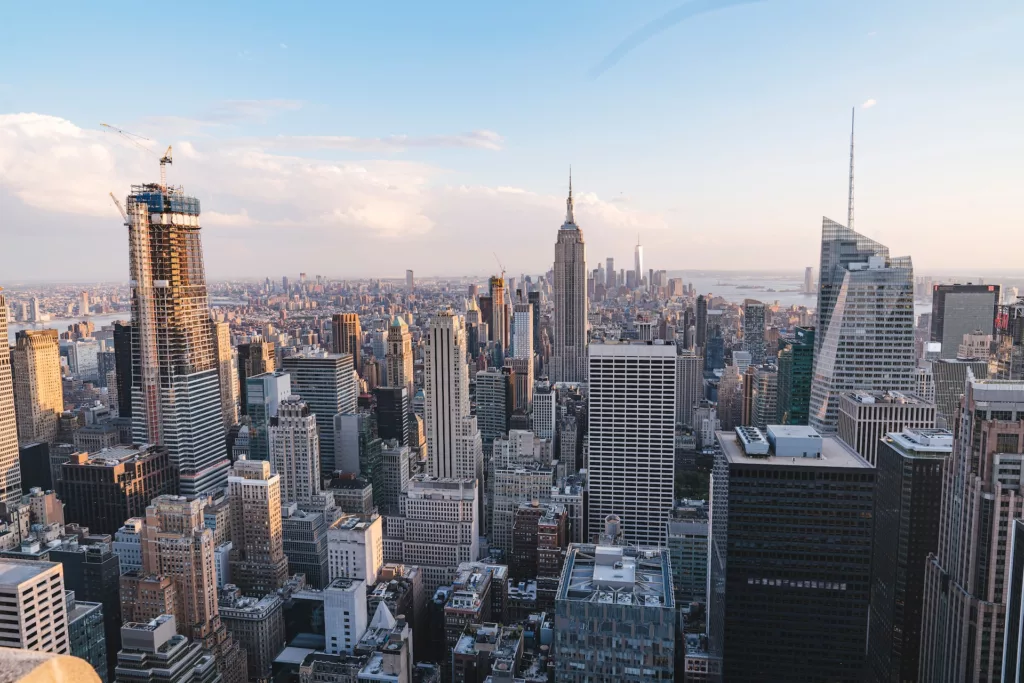
In this guide, we explore the best neighborhoods in NYC, balancing the charm of local living with the practicalities of everyday needs. Each area is a piece of the city’s dynamic puzzle, offering unique opportunities to live, work, and play in the world’s most famous urban melting pot.
Enjoy a Hassle-Free, High End Rental Experience in NYC for Stays of 1 Month or Longer.
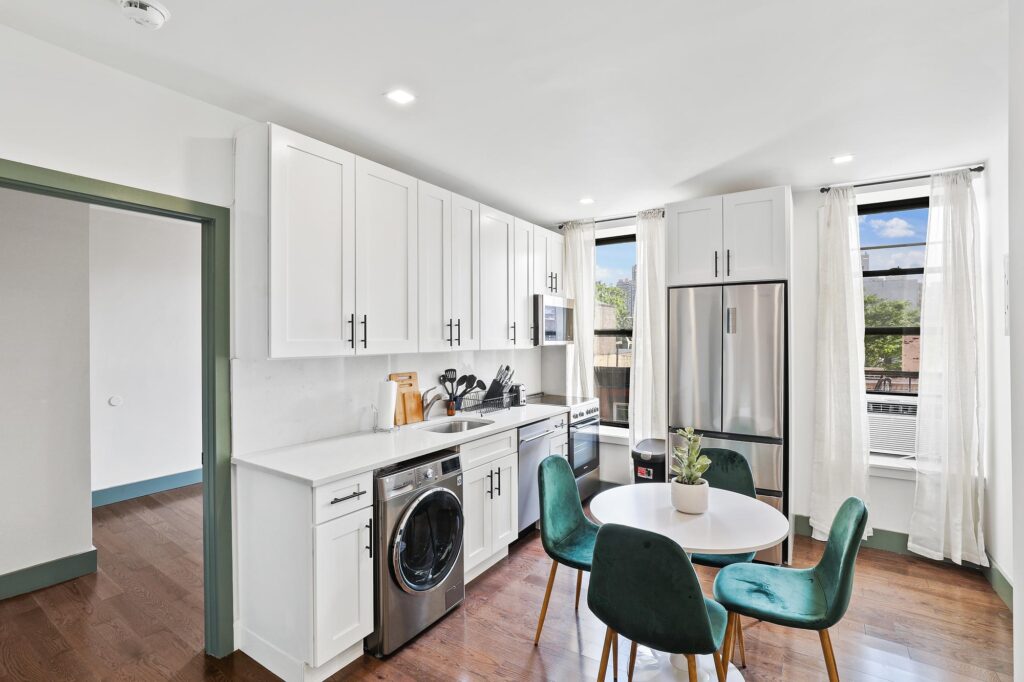




Fully-furnished New York rooms and apartments with flexible lease. Apply today and move in tomorrow.
Upper West Side, Manhattan

Pros:
- Proximity to Central Park and Riverside Park offers abundant green space and recreational opportunities.
- Family-friendly environment with highly regarded schools and a strong sense of community.
- Rich cultural scene, including institutions like the American Museum of Natural History and Lincoln Center.
Cons:
- High cost of living, with real estate and rent prices among the highest in the city.
- While quieter than downtown neighborhoods, it can lack the same level of nightlife and youthful energy.
- Some areas can get crowded, especially near tourist attractions and on weekends.
Overview: The Upper West Side is a quintessential family-friendly Manhattan neighborhood, known for its well-preserved brownstones, prestigious cultural institutions, and proximity to Central Park and Riverside Park. It’s a favorite among families and professionals seeking a balance of city life with quieter, more residential surroundings.
Transportation Options: The area is served by multiple subway lines, including the 1, 2, 3, B, and C trains, offering easy access to other parts of the city. There are also several bus routes running through the neighborhood. The Upper West Side is also bike-friendly, with bike lanes and paths along the Hudson River.
Distance to Central Park: The Upper West Side borders Central Park. Residents can enjoy immediate access to the park, making it a perfect location for outdoor activities and relaxation.
Noise Level: Compared to more bustling parts of Manhattan, the Upper West Side is relatively tranquil. It maintains a calm atmosphere, particularly on the side streets and avenues closer to the parks. However, areas near major thoroughfares and commercial zones can be busier and noisier.
Safety: The Upper West Side is known for being one of the safer areas in Manhattan. It has a relatively low crime rate, and the neighborhood is well-patrolled and family-oriented, making it a secure choice for residents.
Find Short Term Rentals in the Upper West Side
East Village, Manhattan
Pros:
- A rich mix of cultural influences, with numerous music venues, theaters, and art spaces.
- Diverse dining options, from trendy eateries to long-standing ethnic restaurants.
- A strong sense of community and urban charm, with a mix of students, artists, and long-time residents.
Cons:
- Some areas can be quite noisy, particularly near nightlife hotspots.
- Rent prices have been rising, though still more affordable than some other Manhattan neighborhoods.
- Older buildings might lack modern amenities and can be cramped.
Overview: The East Village is renowned for its spirited and diverse atmosphere, a neighborhood where the avant-garde meets the traditional. It’s a magnet for those who appreciate a vibrant cultural tapestry, from punk-rock history to an eclectic dining scene.
Transportation Options: The East Village is served by several subway lines, including the L, F, and 6 trains, providing good connectivity to other parts of Manhattan and Brooklyn. The neighborhood is also well-covered by bus routes and is considered walkable and bike-friendly.
Distance to Central Park: The East Village is about 3 miles from Central Park, a journey that takes around 20 minutes by subway or a pleasant 15-minute bike ride.
Noise Level: Known for its nightlife, the East Village can be bustling and noisy, especially on weekends and evenings. The area around St. Mark’s Place and avenues with popular bars and restaurants tend to be the liveliest.
Safety: The East Village is generally safe, but it’s always wise to stay vigilant, especially late at night. The neighborhood has a busy, energetic vibe, which contributes to a sense of security in well-trafficked areas.
Find Short Term Rentals in the East Village
Williamsburg, Brooklyn
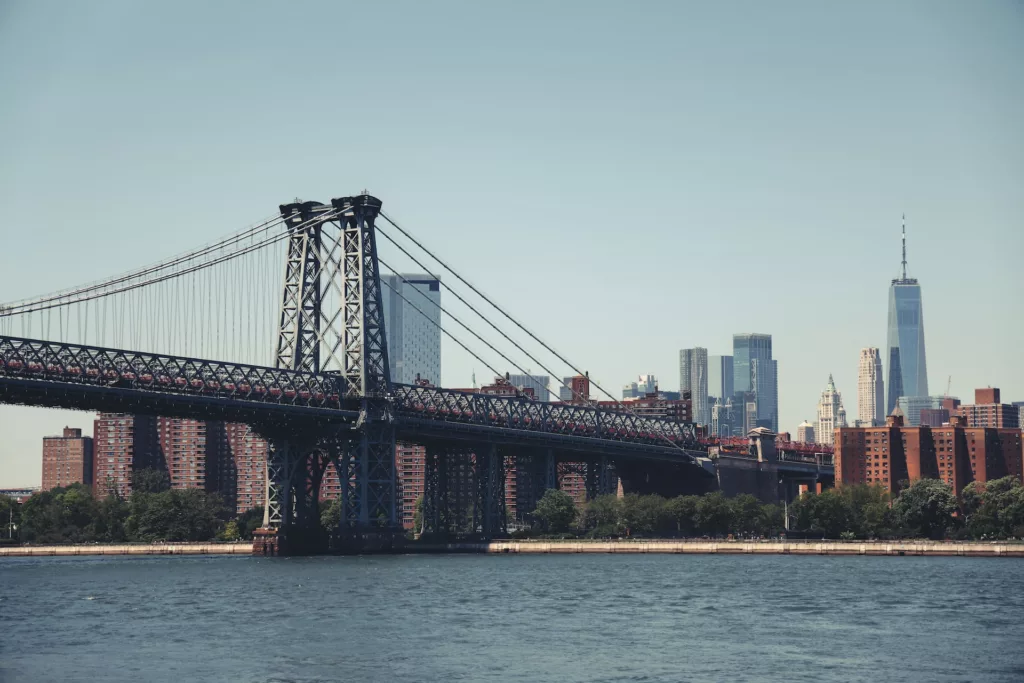
Pros:
- Thriving arts and music scene with numerous galleries and live music venues.
- A plethora of trendy eateries, cafes, and bars.
- Strong community feeling among young professionals and artists.
Cons:
- Higher rent prices due to increasing popularity and gentrification.
- Crowded, especially in commercial areas and during weekend nights.
- Some areas can be noisy, impacting residents seeking a quieter lifestyle.
Overview: Williamsburg is a trendy and vibrant neighborhood, particularly popular among young professionals and creatives. Known for its lively cultural scene, this area is a hotspot for music, art, and fashion.
Transportation Options: Williamsburg is well-served by public transportation, including the L train to Manhattan and several bus routes. The neighborhood also offers ferry services to Manhattan and is bike-friendly, with dedicated bike lanes and Citi Bike stations.
Distance to Central Park: Williamsburg is approximately 7-9 miles from Central Park, depending on the route taken. It’s about a 30-minute subway ride via the L train and transfer to the uptown lines.
Noise Level: The neighborhood can be quite bustling, especially around Bedford Avenue. While it offers quieter residential streets, the main thoroughfares and nightlife spots can be noisy, particularly on weekends.
Safety: Williamsburg is generally considered safe, particularly in well-trafficked areas. Like any busy urban neighborhood, it’s always advisable to be aware of your surroundings, especially at night. The presence of bars and nightlife venues can lead to crowded streets, but the community and local police are active in maintaining a secure environment.
Find Short Term Rentals in Brooklyn
Greenwich Village, Manhattan
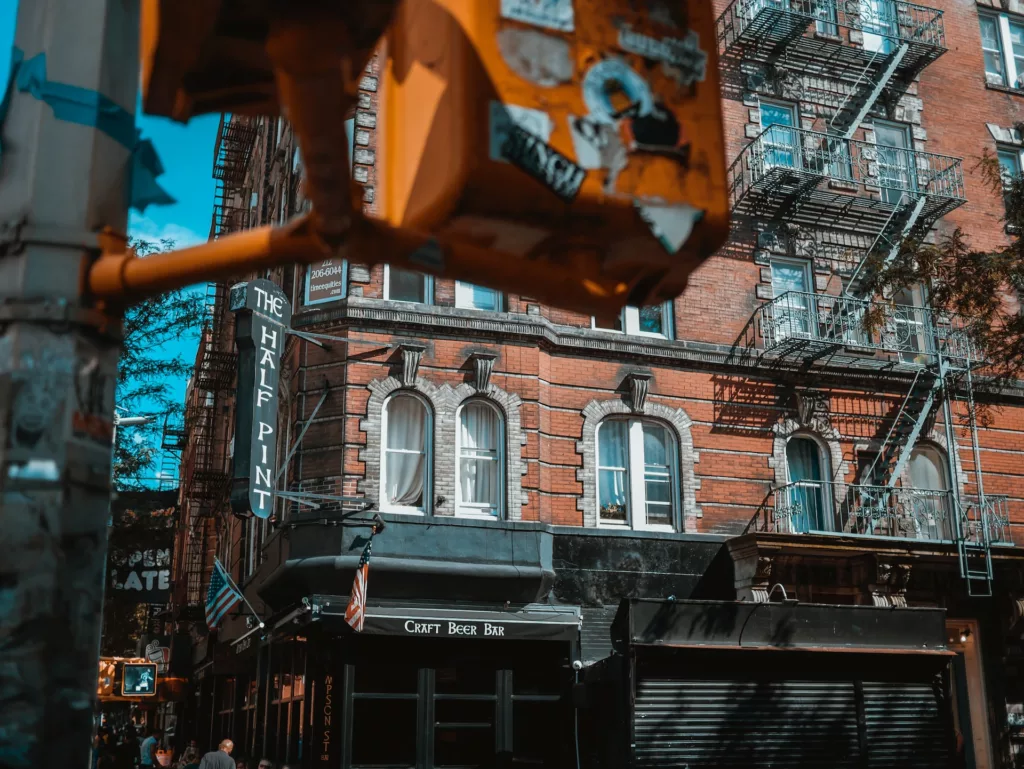
Pros:
- A diverse and inclusive community, particularly welcoming to the LGBTQ+ population.
- Rich in arts and culture, with numerous theaters, jazz clubs, and historic sites.
- Proximity to iconic places like Washington Square Park and NYU.
Cons:
- High living costs, reflecting the neighborhood’s popularity and central location.
- Busy and crowded streets, which can be overwhelming for some residents.
- Limited availability of larger apartments or family-sized housing.
Overview: Greenwich Village, often referred to simply as “The Village,” is a hub of cultural and social diversity, renowned for its historical role in the LGBTQ+ movement. It’s a neighborhood that blends charming old-world architecture with a vibrant and modern lifestyle, making it ideal for singles and young professionals.
Transportation Options: The area is well-connected with several subway lines, including the A, C, E, B, D, F, M, and the 1 train, providing easy access to different parts of the city. Additionally, multiple bus routes serve the neighborhood.
Distance to Central Park: Greenwich Village is about 2.5 miles from Central Park. It typically takes around 15-20 minutes to reach the park by subway or a pleasant 30-minute bike ride.
Noise Level: Known for its bustling streets and lively atmosphere, Greenwich Village can be noisy, especially on weekends and evenings. The presence of New York University adds to the vibrancy but also contributes to higher noise levels in certain areas.
Safety: Greenwich Village is generally considered a safe area, with a strong community presence and active neighborhood watch programs. The vicinity of NYU and its campus security also add an extra layer of safety, though standard precautions for urban living are always recommended.
Find Short Term Rentals in Manhattan
Astoria, Queens
Pros:
- More affordable housing options compared to Manhattan and parts of Brooklyn.
- A diverse and inclusive community with a wide range of cultural influences.
- Excellent food scene, particularly known for Greek cuisine and eclectic eateries.
Cons:
- Nightlife and cultural amenities are more limited compared to downtown neighborhoods.
- Some areas can experience noise, particularly those under the flight path to LaGuardia Airport.
- Subway access is good but more limited in options compared to neighborhoods in Manhattan.
Overview: Astoria is a vibrant and diverse neighborhood in Queens, celebrated for its cultural richness and affordability. It’s particularly popular among recent graduates and young adults, offering a blend of urban living with a more relaxed community feel.
Transportation Options: Astoria is served by the N and W subway lines, providing direct access to Midtown Manhattan. Several bus routes also run through the neighborhood, and it’s relatively close to LaGuardia Airport, making it convenient for travel nurses and frequent flyers.
Distance to Central Park: Astoria is approximately 5 miles from Central Park. By subway, the travel time to Central Park is around 20-30 minutes, making it an accessible option for leisure and recreation.
Noise Level: While parts of Astoria, especially near the main avenues and nightlife spots, can be lively and energetic, many residential streets maintain a quieter, more subdued atmosphere. The noise level is generally moderate but can vary depending on the specific area.
Safety: Astoria is known for being a safe neighborhood with a strong sense of community. The area has a lower crime rate compared to more central parts of the city, but as always, standard urban safety precautions should be taken.
Find Short Term Rentals in Queens
Bushwick, Brooklyn
Pros:
- Thriving arts scene with numerous galleries, street art, and live music venues.
- Increasingly diverse dining and nightlife options, appealing to a range of tastes.
- More affordable compared to other trendy Brooklyn neighborhoods.
Cons:
- Ongoing gentrification has led to rising rents and changes in neighborhood dynamics.
- Some areas are still in the process of development, with varying levels of amenities and services.
- Can be noisy, particularly around main streets and nightlife hubs.
Overview: Bushwick has emerged as a vibrant hub for artists and musicians, known for its street art, eclectic nightlife, and diverse community. This neighborhood has undergone significant transformation, becoming a hotspot for creatives and young people looking for a dynamic urban experience.
Transportation Options: Bushwick is accessible via the L and M subway lines, which connect it to Manhattan and other parts of Brooklyn. The area also has several bus routes, and for cyclists, there are bike lanes and bike-sharing options.
Distance to Central Park: Bushwick is about 7-8 miles from Central Park. The journey by subway, usually involving a transfer, takes about 40-50 minutes.
Noise Level: The neighborhood is lively, especially on weekends and evenings in areas with popular bars and music venues. However, Bushwick also has quieter residential streets that offer a more subdued atmosphere.
Safety: Bushwick’s safety has improved significantly over the years. It’s now considered a relatively safe neighborhood, though, like many parts of NYC, it’s advisable to stay aware of your surroundings, especially at night.
Find Short Term Rentals in Bushwick
Harlem, Upper Manhattan
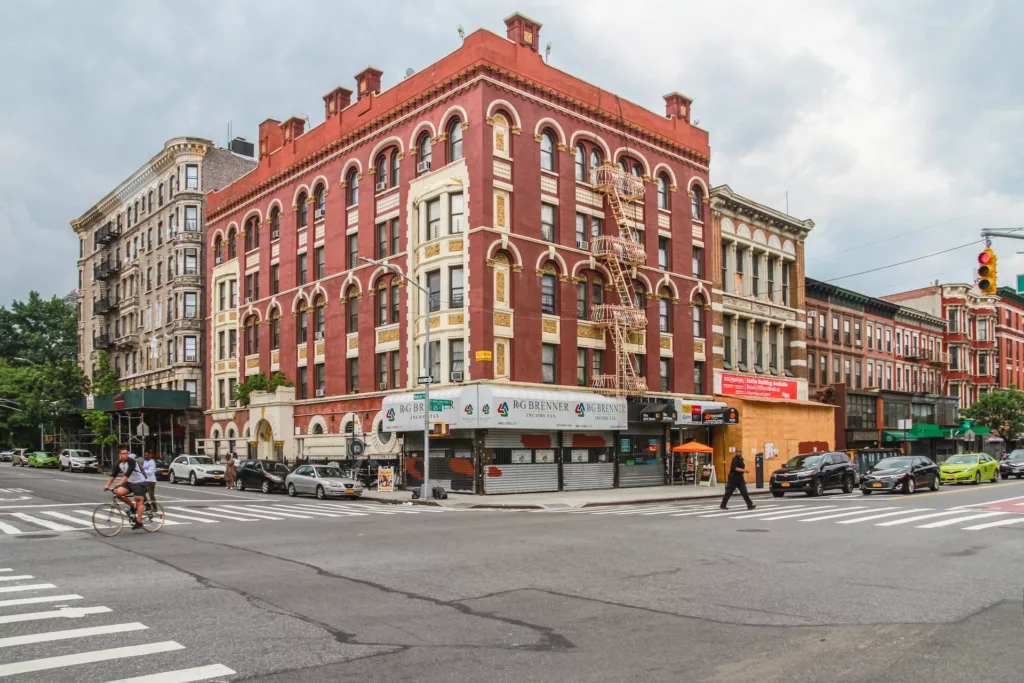
Pros:
- Rich in cultural heritage, with historic landmarks, museums, and theaters.
- Diverse and inclusive community, with a welcoming atmosphere.
- More affordable housing options compared to other parts of Manhattan.
Cons:
- Certain areas are still undergoing gentrification, which brings a mix of benefits and challenges.
- Limited nightlife options compared to neighborhoods in Lower Manhattan.
- Some areas, especially those further north, can feel distant from the city center.
Overview: Harlem is a neighborhood with a rich tapestry of African American history and culture. Known for its vibrant music scene, particularly jazz, and its soul food cuisine, Harlem has a unique and soulful character that attracts a diverse population.
Transportation Options: Harlem is well-connected with several major subway lines, including the A, B, C, D, 2, and 3 trains, offering easy access to downtown Manhattan and other boroughs. There are also numerous bus routes serving the area.
Distance to Central Park: The southern part of Harlem borders Central Park, making it easily accessible for residents. Depending on your location within Harlem, the park can be just a short walk away.
Noise Level: Harlem offers a mix of bustling commercial streets and quieter residential areas. While places like 125th Street can be lively and energetic, especially during the day, the residential areas tend to be more peaceful, especially at night.
Safety: Over the years, Harlem has seen significant improvements in safety. It’s now considered a fairly safe place to live, with a strong sense of community. However, as with any urban area, it’s advisable to stay aware of your surroundings.
Find Short Term Rentals in Harlem
Park Slope, Brooklyn
Pros:
- Family-oriented community with excellent schools and plenty of kid-friendly activities.
- Proximity to Prospect Park, providing a vast green space for leisure and outdoor activities.
- A vibrant local food and shopping scene, with many independent shops and restaurants.
Cons:
- Real estate and rent can be expensive, reflecting the neighborhood’s desirability and family-friendly amenities.
- Nightlife is more subdued compared to neighborhoods like Williamsburg or the East Village.
- Some areas can become crowded, especially near Prospect Park during weekends and events.
Overview: Park Slope is a charming neighborhood known for its tree-lined streets, stunning brownstones, and a strong sense of community. It’s particularly favored by families and professionals for its blend of urban amenities and suburban tranquility.
Transportation Options: The neighborhood is served by multiple subway lines, including the F, G, and R trains, ensuring convenient access to Manhattan and other parts of Brooklyn. Park Slope also has a good network of bus routes and is considered bike-friendly.
Distance to Central Park: Park Slope is about 7 miles from Central Park. The commute typically takes around 35-45 minutes by subway.
Noise Level: Park Slope is generally quieter than many other Brooklyn neighborhoods, especially in the residential areas away from the main avenues. It offers a calm and peaceful environment, suitable for families and those seeking a more relaxed lifestyle.
Safety: Park Slope is known for being one of the safest neighborhoods in Brooklyn, with low crime rates and a family-friendly atmosphere. It’s a neighborhood where parents feel comfortable letting their kids play outside.
Search for Apartments for Rent in Park Slope
Financial District, Manhattan
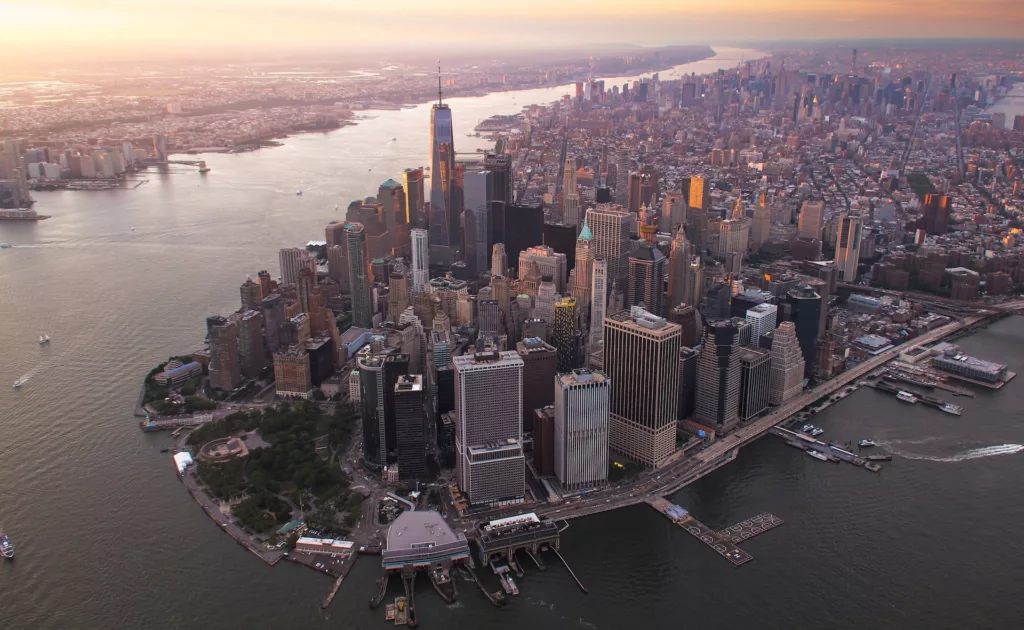
Pros:
- Modern apartments and high-rises, many with excellent amenities and views.
- Proximity to iconic landmarks and the waterfront.
- Quieter on weekends, providing a break from the typical city bustle.
Cons:
- Can feel empty or less lively during weekends and holidays.
- Limited local shopping and dining options compared to more residential neighborhoods.
- Some may find the area too corporate or lacking in traditional neighborhood charm.
Overview: The Financial District, often referred to as FiDi, is the historic core of the financial industry in New York City. Beyond its skyscrapers and business hustle, it has grown into a residential neighborhood offering modern living spaces and a unique urban lifestyle.
Transportation Options: FiDi is exceptionally well-connected, with access to numerous subway lines, including the 1, 2, 3, 4, 5, A, C, J, Z, and the R trains. This connectivity makes it easy to travel to other parts of the city. The area also has ferry access to Brooklyn, Staten Island, and New Jersey.
Distance to Central Park: The Financial District is approximately 6 miles from Central Park. By subway, the journey can take about 25-30 minutes.
Noise Level: The neighborhood is bustling during weekdays due to the influx of professionals but quiets down significantly on evenings and weekends, offering a more relaxed atmosphere.
Safety: FiDi is considered one of the safer areas in Manhattan, especially during business hours due to its high foot traffic. The presence of corporate security and the NYPD around major buildings and landmarks adds to the sense of safety.
Find Short Term Rentals in Manhattan
Long Island City, Queens
Pros:
- Modern living spaces, many with amenities and excellent Manhattan views.
- Growing arts community, with galleries, studios, and the iconic MoMA PS1.
- Waterfront parks and open spaces, offering a respite from urban density.
Cons:
- Ongoing construction and development can be a nuisance for some residents.
- The neighborhood can feel less established in terms of community compared to older, more traditional areas.
- Windy conditions near the waterfront and fewer green spaces compared to neighborhoods like Park Slope.
Overview: Long Island City (LIC) is a rapidly developing neighborhood known for its stunning waterfront parks, modern high-rises, and burgeoning arts scene. It offers a mix of residential comfort and industrial charm, with incredible views of the Manhattan skyline.
Transportation Options: LIC is well-served by public transportation, including several subway lines like the 7, E, M, and G trains, providing easy access to Manhattan and Brooklyn. The neighborhood also benefits from the Queensboro Bridge and ferry services, enhancing its connectivity.
Distance to Central Park: Long Island City is about 3.5 miles from Central Park. The travel time by subway is typically around 20-30 minutes, making it a feasible destination for leisure and recreation.
Noise Level: Given its industrial roots and ongoing development, LIC can vary in noise levels. Areas closer to construction sites or major roads may experience more noise, while the residential parts are generally quieter.
Safety: LIC is considered a safe neighborhood, with a growing community and increased investment in the area. The presence of new developments and community spaces has contributed to a secure and welcoming environment.
How We Selected the Best New York Areas
To identify the best neighborhoods in New York City for renters, our approach was guided by four main criteria. We started by analyzing the average rent prices, a key consideration for anyone planning to move, especially students, young professionals, and travel nurses who often have strict budgets.
Lifestyle compatibility was next. Each neighborhood offers a unique experience – from lively arts scenes to quieter, family-oriented environments. We evaluated how well these areas cater to different personal preferences and needs.
Community atmosphere played a significant role in our assessment. We looked at the sense of community and neighborliness in each area, as these factors contribute significantly to the quality of daily life.
Lastly, we considered how accessible each neighborhood is. This includes ease of public transport, availability of essential services like grocery stores and healthcare facilities, and overall connectivity to other parts of the city.
Our insights were drawn from a variety of sources, including local guides, current resident feedback, and online community discussions.
However, it’s important to note that our guide is not the definitive source of truth. We recommend that potential renters also conduct their own research and visit neighborhoods to find the best fit for their individual needs and preferences.
Insights into Lesser-Known Yet Appealing Neighborhoods
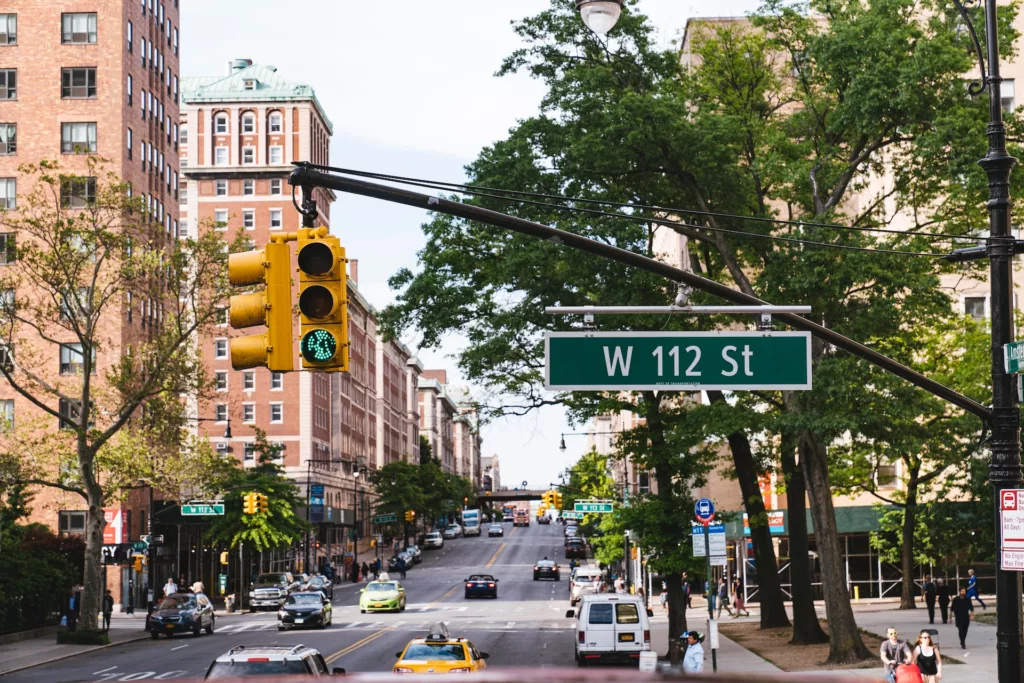
While the 10 best NY neighborhoods highlighted are among the best in New York City, there are several lesser-known areas that also offer unique and appealing living experiences:
- Sunnyside, Queens: A hidden gem with a small-town feel, offering affordable housing and a strong sense of community. It’s known for its diverse population and quiet, tree-lined streets.
- Fort Greene, Brooklyn: Boasting a rich artistic vibe, Fort Greene is a neighborhood with beautiful parks, a vibrant arts scene, and historic architecture.
- Inwood, Manhattan: Located at the northern tip of Manhattan, Inwood is known for its natural beauty, including Inwood Hill Park, and a quieter, more laid-back lifestyle.
- Bay Ridge, Brooklyn: Offering stunning views of the Verrazzano-Narrows Bridge, Bay Ridge is a neighborhood with a mix of urban and suburban elements, known for its diverse cuisine and family-friendly environment.
These neighborhoods, though not as widely recognized, provide unique living experiences that might be more in tune with certain lifestyles and preferences.
FAQ Section
For visitors, neighborhoods like Greenwich Village, the Upper West Side, and Williamsburg offer a mix of tourist attractions, local culture, and convenient access to other parts of the city.
New graduates often find Astoria, East Village, and Bushwick appealing due to their affordable living options, vibrant social scenes, and good connectivity.
Families typically prefer Park Slope, Upper West Side, and Sunnyside for their safety, good schools, and family-friendly amenities.
“Nicest” is subjective, but areas like Greenwich Village and the Upper West Side are often praised for their charm, cultural offerings, and overall livability.
Statistically, Queens often ranks as the safest borough, but safe neighborhoods can be found across all boroughs.
In the vast and varied landscape of New York City, each neighborhood presents its own unique charm and appeal, catering to the diverse needs of its residents. Whether you are on the lookout for short-term rentals in NYC, cozy rooms for rent, or efficient studios, the city’s neighborhoods offer a plethora of options. From the artsy streets of Williamsburg to the serene avenues of the Upper West Side, there’s a perfect spot for everyone – be it students, young professionals, families, or those simply seeking the thrill of NYC living.
These NYC best areas not only provide a roof over your head but also a community to belong to, cultural experiences to indulge in, and a lifestyle that resonates with your personal rhythm. So, whether you’re planning a short stay or looking to plant roots in the city, New York’s neighborhoods welcome you with open arms, promising a living experience that’s as dynamic and multifaceted as the city itself.
